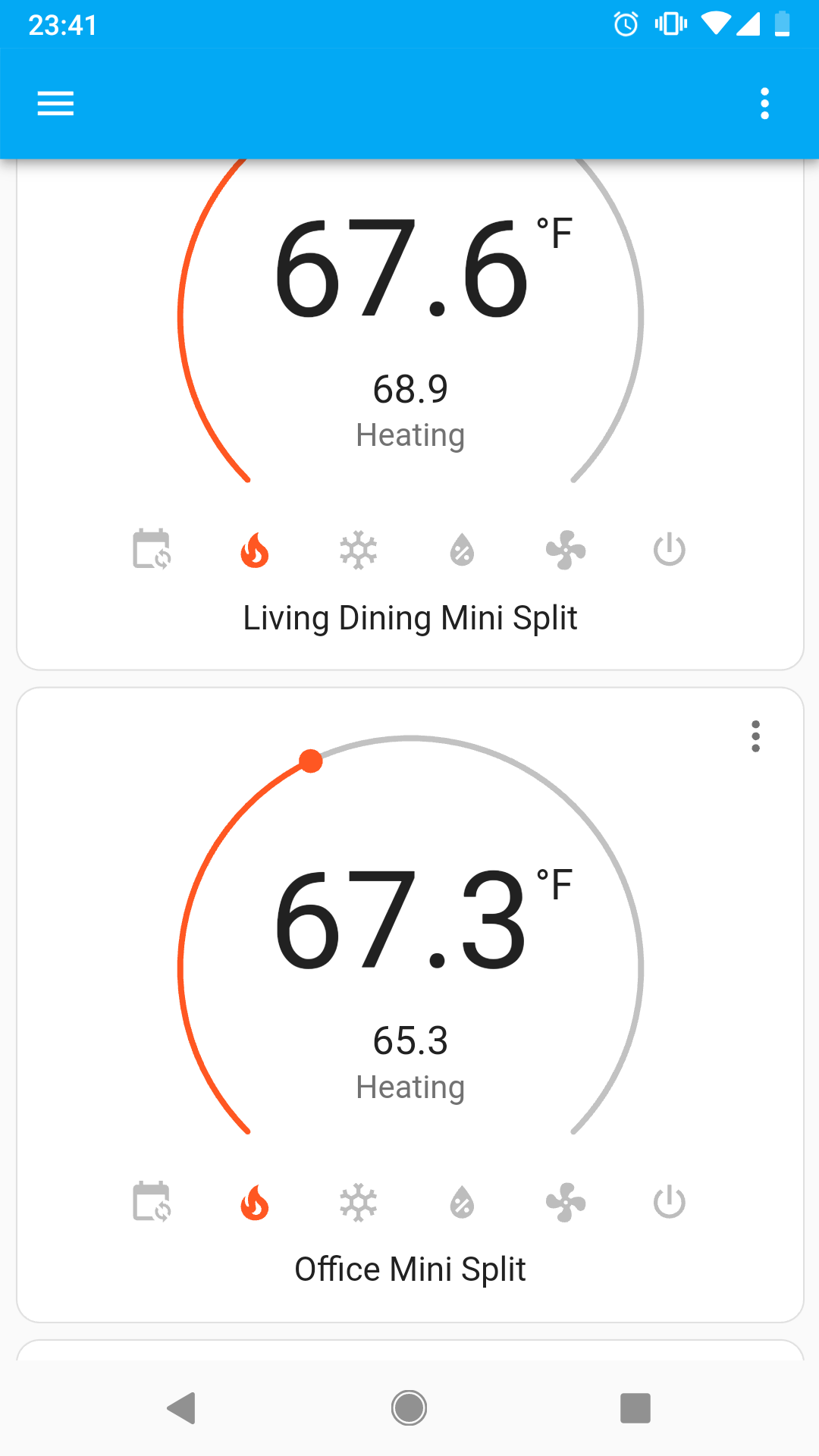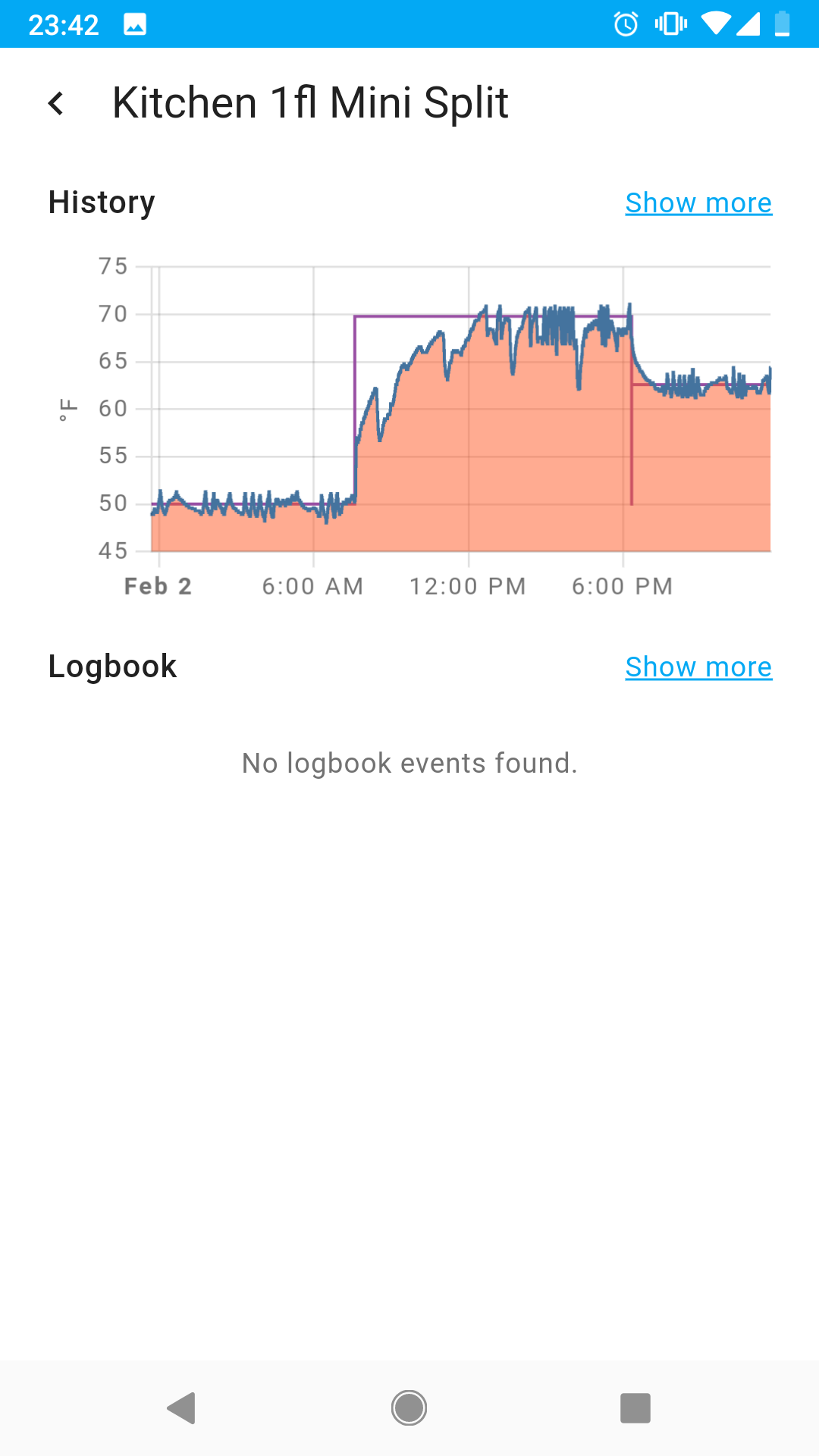I’m not sure the best way to ask or if there is a better community to post…
I’m hoping to use my home server to control my home thermostat but not sure where to start.
Does anyone use Home Assistant for this? Another software?
I’m not sure if I’m allowed to ask about hardware here, but are there things to be aware of in making sure that a wifi thermostat is best suited for the job?
I have ESP8266 WiFi modules running Tasmota firmware for a few parts of this. Some report temperature (and humidity just for fun), I like DS18B20 sensors better than SHT30s which seem to have a bit more self heating. Then I also have Mitsubishi mini split heat pumps for which there’s a Tasmota control library. MQTT for communication + HomeAssistant for UI + AppDaemon for automation scripts in Python.
Examples of the UI in HA:


Wow, very detailed! Thanks
Feel free to ask over at [email protected] too.
But to echo some other comments here, whatever you do, keep it simple and ensure a botched HA update doesn’t freeze / cook you by using standard components as a backup / failsafe
I have a homeassistant instance connected to a no-name Z-wave thermostat. It’s been flawless for almost 10 years.
Zigbee or Zwave temperature/humidity sensors are common. Add a 3-circuit relay box and you can simulate the behavior of pretty much any thermostat with a few rules.
HA or any other system that can toggle outputs based on sensor thresholds would work just fine.
there are some subtleties with real HVAC thermostats, like running your AC compressor at least five minutes and ensuring that it stays off for at least 5 minutes when it’s turned off.
I’d highly recommend not doing that. A smart thermostat is much easier and going to be a lot more reliable. And it won’t stop working if your server goes down.
You can set up a simple, dumb thermostat in parallel, to act as a failsafe. Set it 5 degrees below your lowest heat setpoint, and even if your server crashes, it doesn’t let your house freeze.
@atzanteol @aubeynarf Clarification here There are ZigBee thermostats that are integrated sensors and switches where you can control the switch, read the sensor and control the set point both on the device and via ZigBee so they are controllable locally in two senses - on the device and with the home. There are proprietary Smart thermostats that may be local on the device but rely on external servers for any off device control. then there are Proprietary thermostats that are totally dependent on an internet connection to do anything - Its important to check
It really really depends on what you have for heating.
Floor heating + heat pump? You don’t need to mess around with target temp much because the principle behind it is thermal mass buildup and maintaining that. You have to tune thermostatic valves on the room level. Then you can have one central thermostat simply slightly change the target temperature with many hours of delay. That doesn’t seem too useful to me to automate.
Do you have radiators? Then you can get zwave or ZigBee valves and tie them together with whatever thermostat that you want in home assistant. Then you can set per room/zone heat depending on whatever sensors you have.
Do you have central forced air heating and air conditioning? Then you have pretty much target temp and on/off control unless you want to put in motorized automatic registers or redesign your entire duct system for per-room duct valves.
Individual heat pumps/airco units with radiator based heating is the most “per room” customizable and probably the most useful to put automations on in Home Assistant.
Ventilation can be useful by monitoring CO2 levels and humidity. Then you can use either the fan units themselves or socket switches to actuate those and put whatever sensors you want wherever it is useful.
I am probably missing some stuff here, but there are only a few HVAC setups that actually benefit from automation, in my opinion. Mainly ventilation, infrared, and non centralized forced air heat pumps. Plus heating and cooling is something you want to work 100% flawlessly even if your router dies, your home assistant falls off a cliff, and your ZigBee/zwave controller dies.
I live in a hot climate, so it’s really the expense of air conditioning.
Small adjustments to the temperature based on whether or not we’re home, pre-cooling versus cooling during the heat of the day, etc. makes a big difference on the bill potentially.
I’ve seen some scenarios where people were able to save hundreds of dollars a year just by adjusting the timing of systems. The price of electricity can go up and down during the day.
Maybe those cases are outliers and it’s actually not worthwhile, but it seems compelling. If I can put a system in place for under $100, that will be at least as good as what I have and possibly a significant improvement, I’m interested in trying it.
@gedaliyah @JustEnoughDucks When I got a notification you had commented - I thought it was about this - friendica.ginestes.es/display/…
Dead link
I have a cheap homekit thermostat that I use with home assistant. Being able to turn it off for movies or during peak energy hours is nice. What was most helpful, however, was putting temperature and humidity sensors in every room, so that I could move around heat generating stuff to balance the temps throughout my apartment. I moved my server and gaming pc tower out of my home office. The temperature spread went from 8 deg F to 2 deg F.
Best place to start would be to look at the thermostat hardware you’ve currently got, and start searching online if anyone has integrated it into Home Assistant.
I’ve lived at a few houses now with Home Assistant. In all of them I was able to integrate my HVAC and automate it, but some brands and hardware are definitely easier than others.
I think the most extreme of them required a custom esphome device connected to its PCB to talk to Home Assistant, and another required me to write my own custom component.
Hardware and brands make a huge difference, but sometimes you’re stuck with what you’ve got.
So which was the easiest?
I had a good experience with Daikin split systems, but it’s really going to depend on your region and what’s available in your area, or what you’ve already got. If you’re looking for inspiration on what works well, check the Home Assistant forums.
I got a Venstar T2000. Its at a decent price point, HAOS has built in support for it, and it can work entirely without internet.
Thanks for the tip! Others have mentioned that it’s very tricky to find one that works offline without the manufacturer’s software (website, login, data collection, etc)
Plus 1 to Venstar. Got myself the T7900 and even though it offers internet access, I just blocked it at my router and connected it to the network, controlling it through home assistant. No need for third party access and whatnot with it since it’s completely local.
Same, you can enable local only API. Works great and they have public docs for it’s API. I also have an exporter with grafana graphs.
Each room has one ZigBee thermometer and thermovalves for the heaters. Home Assistant with an automation open and closes them based on the thermometers.
Also in HA, I have a schedule for the “comfort” temperature so that the boiler can be turned on and off accordingly.
See https://wiki.gardiol.org/doku.php?id=homeautomation%3Aheating for the detailed setup.
I have a cheap ZigBee thermostat and some automations to control temp. Works ok, but I’m trying to smarten it up a bit in the next few weeks.
I’ve got a couple Honeywell T6 z-wave thermostats that work great and didn’t cost a lot. I control them through home assistant with some custom code to set them on a schedule, but they can also still be operated manually if needed.
I have the T6 as my main but I cannot do per-room heating because my Sonoff TRV’s cannot talk to it in HA. I got the T6 before working with HA though. In my country the T6 is WiFi and you need the Resideo app.
Does the Honeywell T6 give you separate control of temperature and fan? That is, can you turn air circulation on/off, even when the temperature wouldn’t trigger heating/cooling?
I’ve been watching pm2.5 in my house, and the HVAC filter does a pretty good job of keeping it down if I run the fan, but that fan takes a lot of energy, and I’d like to turn it off when the air is pretty clean.
I believe so, my system is baseboard so I didn’t use a fan. There is a fan control option on the device. The instructions say it can do auto, on, of, circ.
https://digitalassets.resideo.com/damroot/Original/10011/33-00181EFS.pdf
More details here:
TY. Looks like the T6 is pro-only. Googling around, it looks like ventilation control may be one of the things that separate their pro-level T6/T10 from their DIY-level T5/T9. That’s disappointing.
Is it? I guess I don’t know the difference… I installed mine myself but my system is also dead simple - only 2 wires. My first thermostat was just a bi-metallic strip. 😀
I have an EcoBee thermostat which is typically web managed, however it also supports HomeKit. Using the homekit plugin for HomeAssistant I now get best of both worlds.
If I were to do it again I might consider a Z-Wave or ZigBee thermostat, but living in a cold climate I really appreciate knowing that if for some reason my home auto fails there is a backup service to alert me, or vice versa.
Do the Ecobees have any issue if you block their access to the internet? Any issues making it lan only?
I haven’t tried, but I wouldn’t recommend it. It was years ago that I set it up, but I belive it wanted an app. I would stick with one designed for local only.
FritzBox Dect.
Minimal networking footprint utilizing Dect as the transmission protocol.I use an ecobee termostat with Wifi and three extra sensores places around my home. Home Assistant already has an add-on for it, add the thermostat card and it goes to work. Set whatever automations you want.
deleted by creator










